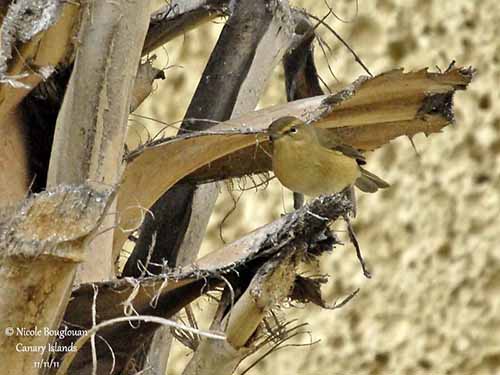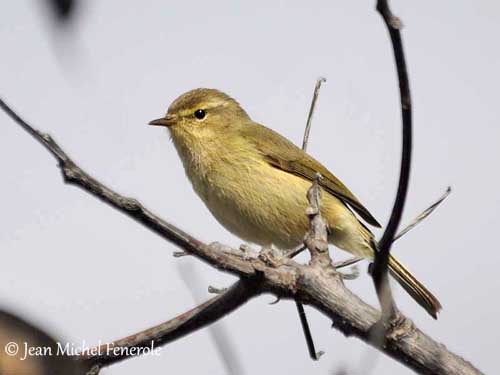
Fr : Pouillot des Canaries
All: Kanarenzilpzalp
Esp: Mosquitero Canario
Ita: Luì delle Canarie
Nd: Canarische Tjiftjaf
Sd: Kanariegransångare
Photographers:
John Anderson
John Anderson Photo Galleries
Jean Michel Fenerole
Photos d’Oiseaux du monde
Nicole Bouglouan
PHOTOGRAPHIC RAMBLE
Text by Nicole Bouglouan
Sources:
HANDBOOK OF THE BIRDS OF THE WORLD Vol 11 by Josep del Hoyo, Andrew Elliott and David Christie - Lynx Edicions - ISBN: 849655306X
BirdLife International (BirdLife International)
Wikipedia, the free encyclopaedia
Wikipedia, la enciclopedia libre
Canary Islands Chiffchaff
Phylloscopus canariensis
Passeriformes Order – Phylloscopidae Family
INTRODUCTION:
The Canary Islands Chiffchaff is a full species with its own voice, morphology and molecular biology. This species is today included in the family Phylloscopidae which gathers the small insect-eaters formerly placed in the family Sylviidae, an Old World warbler family.
The Canary Islands Chiffchaff is endemic to the Canary Islands with two subspecies, but one of them is probably extinct.

DESCRIPTION OF THE BIRD:
Biometrics:
Length: 11-12 cm
Wingspan: 15-21 cm
The adult of nominate race has brownish-olive crown and upperparts, but lower back, rump and uppertail-coverts are brighter greenish-olive. Flight feathers and outer rectrices are narrowly fringed pale green to yellow.
On the underparts, chin and throat are white, whereas lower throat and breast are mostly dull yellow. Lower breast and belly are washed buffish-brown. Flanks are warm buff and undertail-coverts are pale yellowish. On the underwing, coverts and axillaries are yellow.
On the head, the crown is brownish-olive. Cheeks and ear-coverts are olive-brown. We can see a whitish supercilium and a narrow, white eyering, both contrasting with a dark eye stripe.
The thin bill is dark horn. The eyes are dark brown. Legs and feet are grey-brown to yellowish-brown, but the feet can be paler than the tarsi.
Both sexes are similar.
The juvenile has usually brighter yellow underparts.
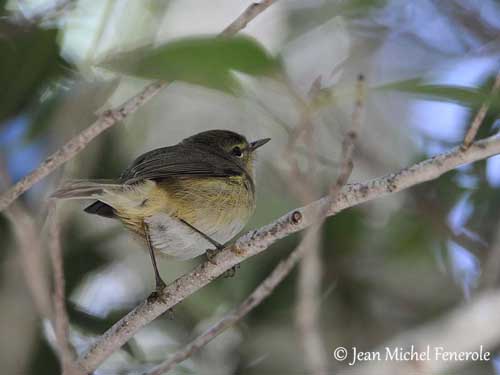
SUBSPECIES AND RANGE:
The Canary Islands Chiffchaff has two subspecies.
P.c. canariensis (here described) is found in W Canary Islands, including La Palma, Hierro, Gomera, Tenerife and Gran Canaria Islands.
P.c. exsul occurred in NE Canary Islands, on Lanzarote Island and probably Fuerteventura Island too.
This race is slightly smaller than nominate, with paler olive-brown plumage. Tarsi were almost black.
It is probably extinct, but the cause is unknown. Destruction of the habitat could be the main cause of this extinction.
HABITAT:
The Canary Islands Chiffchaff of nominate race is usually found in urban gardens, scrub, bushes, pine forest, edges of cultivated areas, from sea-level to tree line.
The race “exsul” occurred in cultivated areas, euphorbias, cactus scrub, shrubs and fig trees (Ficus).
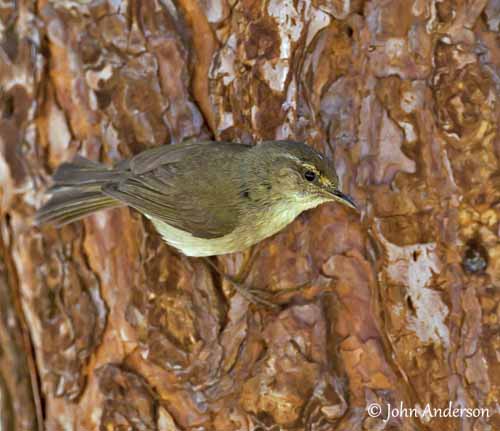
CALLS AND SONGS: SOUNDS BY XENO-CANTO
The Canary Islands Chiffchaff of nominate race has similar voice that the Common Chiffchaff (P. collybita), but with faster song and more explosive notes. It utters sharp, clear “hwit”, “huii”, or “wheet” notes. The song starts with explosive “dschi, dsche, sche, schi, sche…” and then, it accelerates towards the end. During the song, the voice is richer and deeper than that of Common Chiffchaff.
The calls of the race “exsul” were longer and harsher.
BEHAVIOUR IN THE WILD:
The Canary Islands Chiffchaff feeds mainly on insects caught in the foliage. It forages at all levels, from the ground to the forest canopy. However, it can be seen hovering in the air too. It also consumes nectar from flowers, hovering at the corollas like a Trochilidae species.
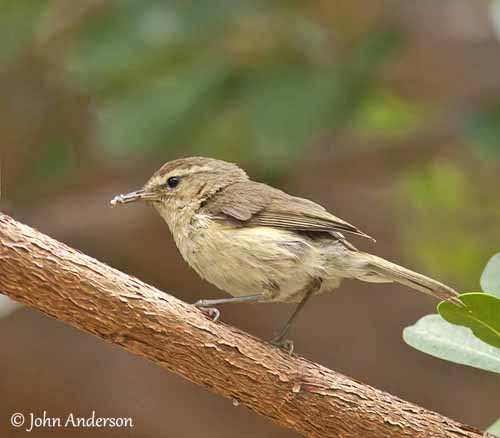
Like the Common Chiffchaff, it is very active and always moving. It flicks the wings and wags its tail frequently.
On the ground, this tiny bird moves by hopping or creeping along among the vegetation.
The Canary Islands Chiffchaff is usually seen alone or in pairs during the breeding season, but after the reproduction, they often form small groups during autumn and winter. They are very secretive birds, often heard before to be seen.
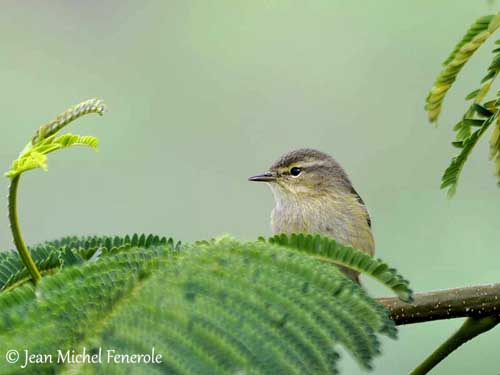
Males are conspicuous only during the breeding season, when they are calling from exposed perches.
The species is territorial all year round, involving some disputes accompanied by songs and calls, threat displays, chases and fights.
The Canary Islands Chiffchaff is sedentary in its range.
Its rounded wings are not those of a migratory bird. The flight is jerky and flitting.
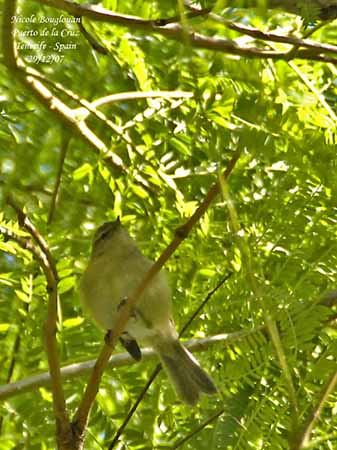
REPRODUCTION OF THIS SPECIES:
The breeding season occurs between January and July.
The nest is placed in tree, palm or laurel, tall bush, sometimes in hole or under a roof, rarely on the ground. This is a ball-like structure with side entrance. It is primarily made with dry grasses and moss, but other materials such as flower petals, dry leaves, plant fibres, hair and feathers can be added too.
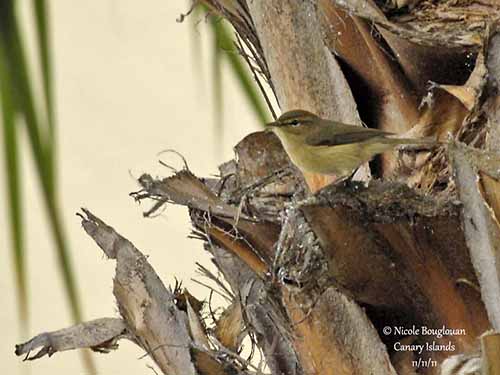
The female lays 4-7 whitish eggs with dark markings. The incubation lasts 13-15 days. Both parents feed the chicks. They fledge about 14-16 days after hatching.
There are probably two broods per season.
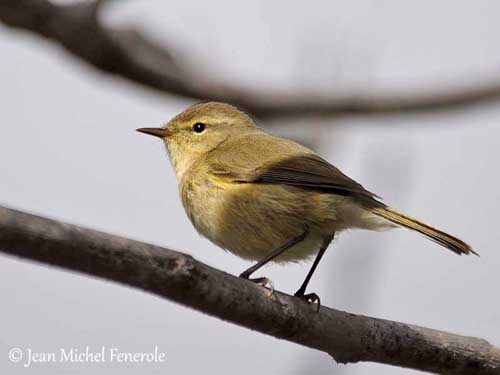
PROTECTION / THREATS / STATUS:
The Canary Islands Chiffchaff of nominate race has stable populations in spite of predation by introduced mammals.
There are no recent records of the race “exsul” which is now probably extinct.
The Canary Islands Chiffchaff is not currently threatened in spite of relatively restricted range. Its population is estimated at about 100,000/150,000 breeding pairs.
